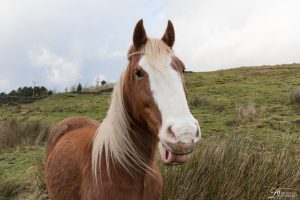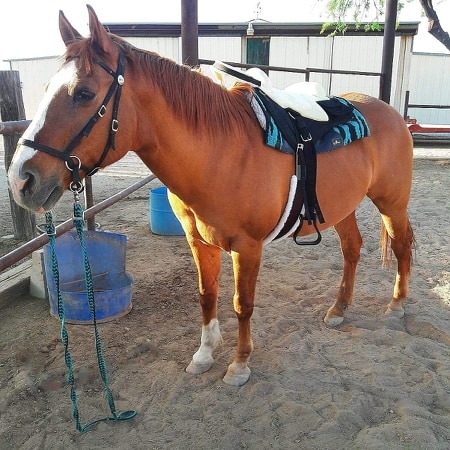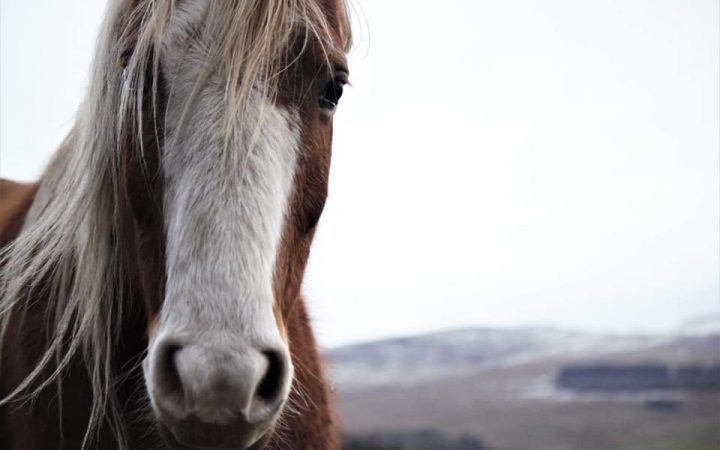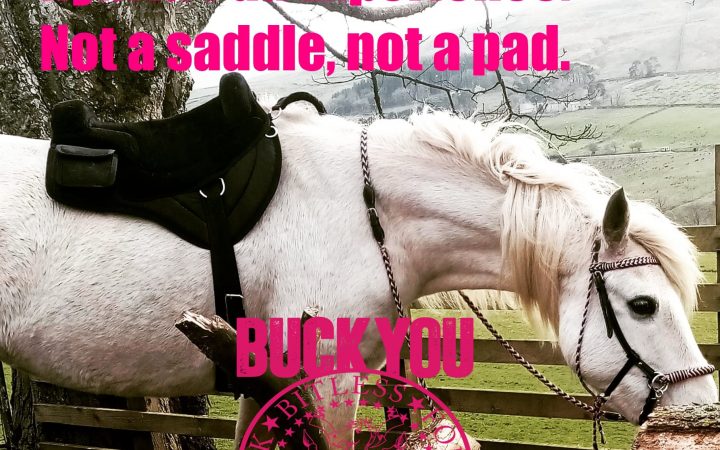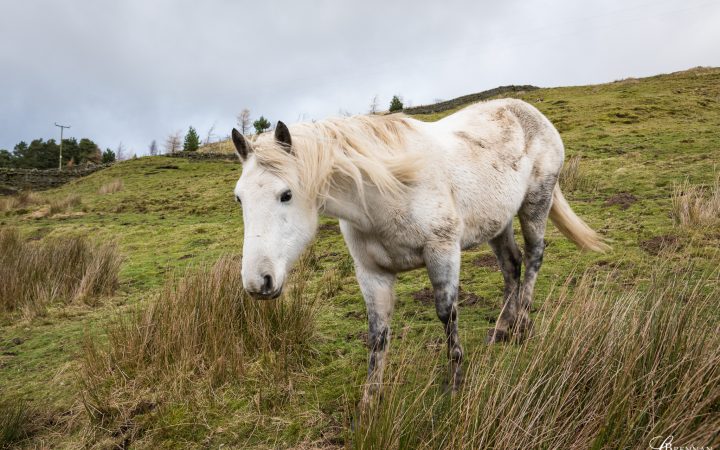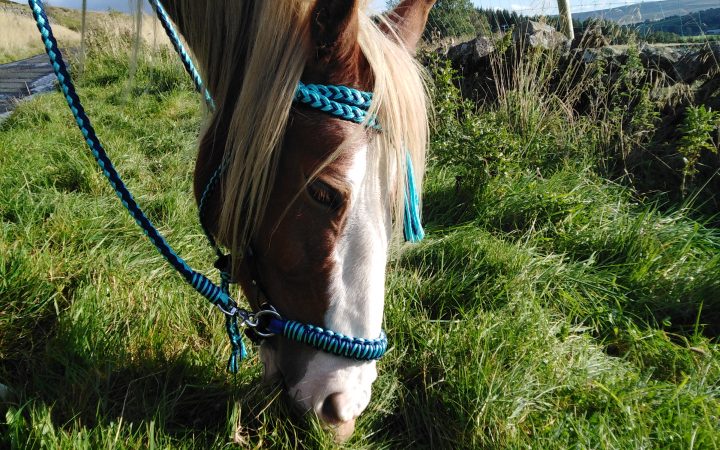You may have observed that as well as super-awesome bareback pads, gorgeous sidepull bridles and LOTS of stunning ponies, i also bang on a fair bit about force-free training, positive reinforcement and such like.
I’m hoping you’re interested, and this is the place you can find out more!
So what is positive reinforcement and how does it change how we work with horses?
All animals learn through consequences be they good or bad. This is known as Operant Conditioning. Actions which result in good outcomes are more likely to be repeated, actions which have bad outcomes- like punishment, are less likely to be repeated. We can use this to teach animals all manner of things . There are 4 aspects to this manner of learning, +R, -R, +P and -P.
The + is ‘Positive’, in the mathematical sense to ADD. The R is Reinforcement, so +R means to ADD something to REINFORCE a behaviour we would like to see more of.
With animals, the easiest thing to add is a food reward.
Again, the – is the mathematical symbol for subtract, so to remove. This is what is known as Negative reinforcement/punishment.
The P stands for punishment.
Punishment is commonly used to REDUCE a behaviour from happening. For example, a horse bucks and he is smacked with a whip to reduce the bucking behaviour. Eventually he learns that to avoid the whip, he should not buck.
Another example is a horse who nips who gets smacked in the face. This can however have a two fold unwanted effect. 1) he will still nip but learns to move his head away fast! And 2) he will become hand shy. Punishment only works as long as the punishment is worse that what the horse is worried about, be that a scary thing, pain, anxiety, badly fitting tack etc.
-P is removal of something the animal wants to punish a undesirable behaviour. So if you have a treat pouch on and he is trying to get to it and you take the pouch off and put it out of reach, this is -P. A child having a toy taken away is -P.
-R is the most commonly used method in traditional horse riding and training. This is negative reinforcement. This is more commonly known as Pressure and Release.
There are many examples of this. A very common example is when asking a horse to walk on, we are often taught to squeeze our legs. If the horse does not respond to a gentle squeeze, we are told to squeeze harder and add a little kick. We release this uncomfortable pressure when the horse does the desired behaviour- in this case, walking on.
Eventually the horse learns that to avoid being kicked on, he should respond to the cues quickly to prevent escalation of the squeeze to a kick.
The same method is used for picking up feet- we are told to let him have his foot back WHEN he stops resisting, so we remove the stimulus the horse does not like when we get the behaviour we like.
I feel that -R and +P are two sides of the same coin. You cannot remove an uncomfortable stimulus unless you apply it in the first place.
It is often said that the release is the reward. I do not believe that RELIEF from an uncomfortable or painful situation is a reward, I feel that as responsible horse guardians, we should not be placing our horses in situations where they feel uncomfortable or in pain.
There are times in a horses life where they will be in uncomfortable or painful (vets, emergency situations) and the best we can do is train in preparation as best we can to give them the tools to handle it.
Why should we use +R?
Training with +R creates confident, cooperative and happy horses. These horses are more likely to be accepting of situations that are scary, painful or unnatural than horses trained using other methods.
This is for many reasons such as: The horse trusts his/her trainer as the trainer is associated with GOOD things and therefore the horse feels that being around this person will lead to good experiences.
They are cooperative with all manners of their handling and care, from coming when called, picking up their own feet, putting on their own tack, playing games, all sorts of things.
Training with +R releases dopamine and serotonin, which helps memory and focus, and also helps reduce aggressions and depression.
I have found this works on both horse and trainer.
Horses who feel safe and confident have a more positive attitude to novel stimuli and strange situations. They see new things as an opportunity rather than as a threat.
As an example, Cato saw an open wheelie bin over-stuffed with cardboard which was flapping in the wind. He took it upon himself top approach and target it rather than avoid it or run away. This was fine until he took it too far and started pulling it all out of the bin! He is also very excited when he sees any road works or road signs as these are opportunities for reinforcement and things to target!
Horses trained with +R are also better at learning new and complex behaviours. Traditionally trained horses learn how to avoid discomfort and won’t offer new behaviours for fear of getting it wrong and being told off, but +R trained horses go into situations looking for behaviours to perform to earn reinforcement.
+R creates horses who experiment, are curious and who like to solve puzzles and learn new things.
+ R can be used for pretty much anything you can think of, from the first steps of handling to dressage moves. Studies have also proven that horses retain behaviours learned with +R far better than behaviours learned with other means.
Above all, if we can use a method which doesn’t rely on pain, fear, force or coercion and creates happy, friendly, relaxed horses, why wouldn’t you?
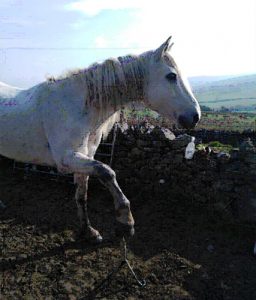
The only drawbacks for using +R are all for the human. When we use +R we have to respect the feelings and preferences of our horses. We may really want to hack out alone, but if our horse finds this aversive, no matter how big the rewards, we have to respect this as to force him to do otherwise would mean using +P and -R.
Using +R can take longer than using traditional methods as our horses are learning a behaviour, not learning how to avoid us turning nasty.
That said, once the behaviour is learned, it takes a firmer root than avoidance based behaviours, and creates a far more solid and safe foundation.
How do we get the behaviour to reinforce?
There are several methods we use to get the behaviours we want to reinforce. Luring, moulding, shaping, targeting and capturing,
Capturing- we literally capture the animal doing the behaviour and reinforce it. So if we wanted to reinforce a dog for sitting, we might wait until he sits and give him a treat.
This is great, but of course, we don’t always have hours to wait for an animal to inadvertently perform a behaviour we want to capture!
Luring- using a lure (usually food) to manipulate that behaviour into happening
Targeting- the same as luring but the animal has learned to follow a target in order to gain reinforcement.
Shaping- we build a behaviour in tiny increments. For example lining up at a mounting block. We would start by reinforcing for being near the block, then we would raise the criteria and reinforce for being next to it, then standing parallel to it, then for staying there etc.
Moulding- not a fan of this one, this is where the animal is physically manipulated into the position/behaviour we want, then bridged and reinforced once there. For example, using pressure on a lead rope to ask a horse to lower his head. This can quickly become -R or pressure/release, also the behaviour is not offered, but made to happen, which removes the aspect of thinking and problem solving that +R is so good at creating for animals.
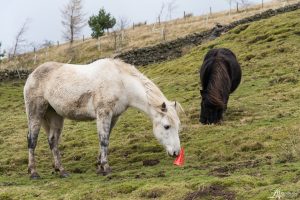
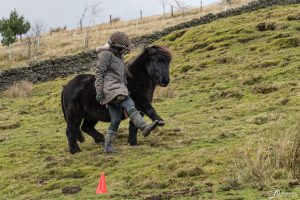


Common misconceptions about positive reinforcement:
Training with treats creates horses who bite! This can be true, if horses aren’t taught correctly how to behave when working with treats you can very easily end up with horses who bite or mug, Like with any type of training, if it’s done badly you don’t get good results.
This is why the very first thing we teach our horses is a foundation behaviour on how to behave around food based rewards.
It’s bribery
No, bribery is saying ‘Take a dive in the 3rd round and there will be a big wad of ££ in it for you’. We are rewarding or PAYING for behaviours, not bribing horses to do them!
Horses don’t use treats for other horses
No, but they also don’t ride other horses, so we can clearly state that we are not horses, horses know we are not horses, so a human-horse relationship is preferable! I DO NOT want them treating me the same way they treat each other!
He won’t do anything unless I have treats.
Actually, after a while, the cued behaviour itself becomes reinforcing! As horses become more proficient, we can start creating behaviour chains and adding more duration. We still reward the behaviours, but we ask for a lot more to earn that reinforcement. We have to build up to this slowly, If we go too fast, they horse can decide it’s not worth the effort.
It’s great for tricks, but can you ride?
Yes! You can use positive reinforcement to teach your horse to do pretty much anything. All basic husbandry from leading to haltering to foot handling to tacking to riding up to dressage moves can be taught using positive reinforcement,
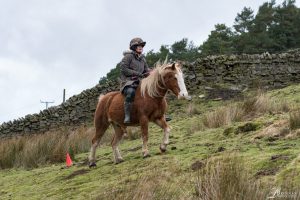
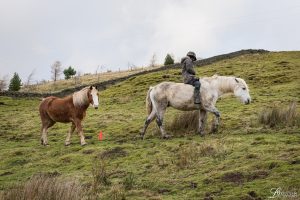
He should do it because he respects me and wants to please me.
Uhuh, and how would you feel if your boss told you you weren’t being paid any more for that reason?
So you just let your horse do anything? What if a bus was hurtling towards him? You’d just let him stand there rather than use force and make him feel uncomfortable to move him?
That is actually something i’ve heard a few times! And no, I would use any means necessary to move him much as I would for any of you lot if you were about to get hit by a car and I had to knock you out of the way.
I’d apologise later, but the important thing would be keeping you alive.
Emergency situations do happen, and this is why we have what we call a Trust Bank. We bank so much GOOD experiences with our horses, that when we have to do something they don’t like, we are still in credit with them with GOOD so we can afford to go down a little in their estimation for a short period of time without ruining all the work we’ve put in.
How we keep our horses:
How we keep our horses has a huge impact on their mental, emotional and physical well being.
It is important to ensure our horses are kept in a species correct manner before we attempt to embark on training.
We cannot successfully train a horse who has anxiety from lack of company, stomach pain from incorrect feed or is suffering with injury or illness.
The Animal Welfare act has decreed that all animals have the right to the following:
Freedom from hunger and thirst: by providing enough fresh water and the right type and amount of food to keep them fit.- For horses, this means always having access to some form of forage.
Horses have evolved as trickle feeders, designed to be chewing/occupied by feed for a large portion of their day. Their digestive systems are primarily designed to digest fibre and, therefore, forage (hay/haylage/grass) should represent the majority of their diet.
Wild horses spend about 60% of their time eating. This compares to stabled competition horses kept in individual stables and fed rationed feed where only 15% of their time is spent eating. Although these horses usually receive good nutrition, their eating is done over 4-5 hours; a third of the time spent by wild horses who are free to graze at will (16-18 hours per day).
Ideally domesticated horses should have free access to fibre to allow them to eat for at least 16 hours per day and clean drinking water.
Freedom from discomfort: by making sure that animals have the right type of environment, including man made or natural shelter and somewhere comfortable to rest.
Horses evolved as a social species living in open plains where running away was their primary method of escape from predators. Today, horses still possess an inherent aversion to isolation and confinement. Research has shown that horses with free access to both pasture and to box stalls with bedding, hay and water, prefer pasture even during poor weather as long as some grass is available.
While horses do need some protection from the elements – shelter, trees, barn – they do not require warm housing and have been shown to be able to comfortably tolerate low temperatures. Horses naturally insulate themselves with their winter coats; however, horses with clipped coats may need rugs to maintain a comfortable body temperature. Anything that a horse wears, be it a rug, headcollar, bridle or saddle, needs to fit correctly and be cleaned regularly.
Horses that are in work should only be asked to do what they are capable of and what they enjoy.
Freedom from pain, injury and disease: by preventing them from getting ill or injured and by making sure animals are diagnosed and treated rapidly if they do.
It is important to make sure all reasonable steps are taken to prevent ill-health and to seek prompt veterinary care in the event of illness or injury.
A preventative health care plan should be implemented which should include worming and vaccinations. Your vet will be able to discuss an appropriate plan for your horse.
Freedom from fear and distress: by making sure their conditions and treatment avoid mental suffering. Unfortunately, many training and handling methods do not reflect this.
Horses evolved as a social species living in open plains where running away was their primary method of escape from predation. Movement and grazing will naturally dominate the majority of a horse’s time. Therefore, confining horses to individual stables or paddocks may be insufficient to meet their social and mental needs. Distress may result from lack of social interaction and space.
Freedom to behave normally: by making sure animals have enough space, proper facilities and the company of other animals of their own kind.
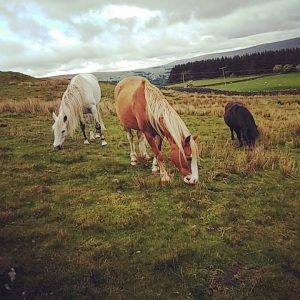
Horses are social, nomadic animals that prefer to live and move in groups over large open areas so they can flee from danger. Horses naturally partake in mutual grooming as a means of bonding and to develop a herd hierarchy (pecking order). Unfortunately it is almost impossible to provide this type of environment for the domesticated horse and it is easy to place human needs and preferences before the needs of a horse.
Chronic frustration from isolation, lack of social contact, lack of environmental enrichment and/or lack of stimulation can result in abnormal or stereotypic behaviours (‘stereotypies’). Abnormal behaviours include pacing, licking, eating or chewing of non-food objects. Stereotypies are repetitive behaviours horses use to cope with the abundance of time that would otherwise be spent grazing and socializing. Examples of stereotypies include crib biting, weaving, wind sucking, head tossing and head nodding. Unfortunately some stereotypies become learned behaviours that cannot be resolved, even after the horse has been removed from the environment that initially triggered the behaviour (e.g. wind sucking).
Try and make the environment as natural as possible for your horse by ensuring they have at least one friend to interact with and a field to run around in for at least some of the day, while able to move in all gaits.
Emotional State:
Once we have established our horse has all of his physical and emotional needs met, we need to ensure he is calm and happy when we start training. We do this by making sure we have the following:
-Alternative forage
-PC
-liberty
-Friends.
We always make sure an alternative food source such as grass or hay is available when we train. This is to ensure our horse is participating through choice, not because we have the only available food. If he does not want to be near us, but we have the only food, this creates feeling of conflict in our horse.
We also use low value treats such as fibre nuts or chaff so we don’t over-excite our horse. The emotional state of the horse is crucial when training.
We aim for them to be relaxed and calm. Over excited horses cannot focus, frustrated horses become angry, which leads me to PC, or, Protected Contact. This means working with your horse over a barrier, This can be a gate or fence, or even a pole propped up to create a ‘barrier’. This is on small part to keep you safe if your horse becomes angry or snatchy, but also, and very importantly, to enable your horse to feel safe.
Many horses have had bad experiences with humans and do not feel safe in their company. By creating a barrier with give our horse comfort that we cannot ‘get’ them, and also enable them to move away from us if they feel they need space, without us following after them.
This is also why we like to work with horses at liberty- again, so the horse can choose whether they wish to remain working with us or not.
Friends- it is very unnatural and scary for horses to be away from the company of their group, so we ensure our horse can easily see his friends when training, although it is usually necessary to create a barrier to prevent them from coming over to try to join in, or to provide them with enough food/distraction to keep them busy while you train. Too far away and your horse will be worried about being left alone, too close, he can worry they are going to steal his treats!
This is a small intro to a very big topic, but you can learn more! Join the group facebook.com/horsecharming to meet friendly people and meet the other Horse Charming professionals or contact me personally and we can discuss your needs and work out a plan for you and your horse.
We work mostly by video coaching and we offer unlimited support so it’ affordable and incredibly supportive, and you will join a friendly network of people all working with the same values as you.
I also offer introduction to Force Free horsewomanship (well, personship really!) at our home moors with the assistance of the Fabulous, Wonderful, Handsome and Adorable BuckYou ponies for small groups of 4-8 people at a time. These sessions generally last about 2 hours, are very friendly and informal, and we can be very general and just do a basic introduction, or we can focus on any particular area you have a specific interest in hoof handling, non-aversive ridden cues- whatever you wish to discuss. These are £20 per person and do include a cuppa!
If you’d like to organise one, just drop me a message and we can arrange a date.
